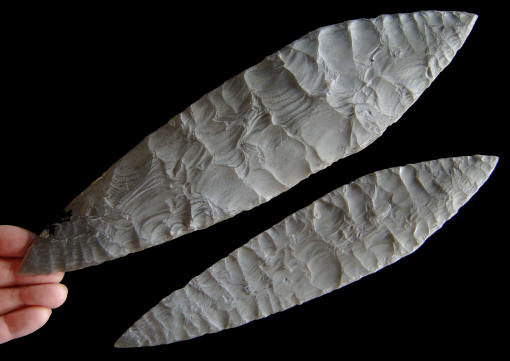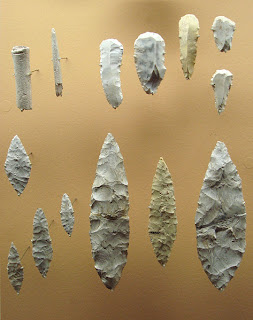 |
| Blombos point |
Since I started reading about the MSA (Middle Stone Age, the main African Middle Paleolithic stone industry) I have been under the impression that it had Solutrean affinities.
Well, now it is confirmed that at least some MSA crafters, those from Blombos Cave, South Africa, effectively used this technique some 35,000 years before it was known in Europe.
Vincent Mourre et al. Early Use of Pressure Flaking on Lithic Artifacts at Blombos Cave, South Africa. Science 2010. Pay per view.
Abstract
Pressure flaking has been considered to be an Upper Paleolithic innovation dating to ~20,000 years ago (20 ka). Replication experiments show that pressure flaking best explains the morphology of lithic artifacts recovered from the ~75-ka Middle Stone Age levels at Blombos Cave, South Africa. The technique was used during the final shaping of Still Bay bifacial points made on heat-treated silcrete. Application of this innovative technique allowed for a high degree of control during the detachment of individual flakes, resulting in thinner, narrower, and sharper tips on bifacial points. This technology may have been first invented and used sporadically in Africa before its later widespread adoption.
Very few stones types (obsidian, jasper, high quality flint) can be retouched this way without previous thermal modification (heating the stone appropriately). This was the technique used at Pinnacle Point, not far from Blombos in that very same time. The technological sophistication is such that it has been compared to metallurgy.
While Pinnacle point offered the first evidence of stone preparation through heating in order to improve knapping, Blombos has the first one of pressure retouch. Other evidence of the so-called modern behavior (symbolism, art, etc.) is also abundant in the South African MSA. Even food processing is known from that time in nearby Mozambique.
Source: Science Daily.
Solutrean points (or casts):
< From Don's Maps:
A cast of a Solutrean "laurel leaf" spear point, over 13 inches long. These delicate and beautiful implements were prepared by delicate flaking across the surface. Many are so large and delicate that they could never have been actually used, and may have been status objects.
Photo: Man before history by John Waechter
Photo: Man before history by John Waechter
< From Lithic Casting Lab:
VOLGU LAUREL-LEAF POINTS (CASTS) - SOLUTREAN PERIOD
LE VOLGU - EASTERN FRANCE - UPPER PALEOLITHIC PERIOD
Francois Bordes wrote that "The majority of these specimens (Volgu cache) were chipped by direct percussion; but for the finer ones, indirect percussion or pressure has been used." Jacques Bordaz wrote that "The obvious fragility of some of the specimens (Volgu cache) suggest rather a ritual use, or perhaps they were simply examples of some knapper's bravura."
A more complete toolkit from Solutré-Pouilly.
Another culture that used the same technique later on was Clovis culture in Holocene North America.



Hi!
ReplyDeleteI like this blog a lot.So, I'll follow it.
The last post is very interesting for me, because I feel fascinated by prehistorical technology.
Kindest regards.
Welcome around. :)
ReplyDeleteI find even more notable the evidence for bone tools of a similar age in Africa. Bone toolmaking is one of the ubiquitous indicators of modern human behavior that is very rare in archiac homonin populations.
ReplyDeleteThe two technologies combined make the case for quite advanced middle stone age technology in Africa as far back in time as genetical mutation rate dates for Khoisan-non-Khoisan splits at the very base on the Y-DNA (haplotypes A and B) and mtDNA (haplotypes L0 and L1) trees, and around the time of the earliest Out of Africa events.
But bone tools are also more generic and older in Europe. Not all local variants used them but they are definitively as old as the first UP technologies (Ahmarian/Emirian and related).
ReplyDeleteMy surprise was more about the affinity with Solutrean tech, something I had already visually observed in MSA industries in general but did not know it reached such high detail of technological identity.
"The two technologies combined make the case for quite advanced middle stone age technology in Africa as far back in time as genetical mutation rate dates for Khoisan-non-Khoisan splits at the very base on the Y-DNA (haplotypes A and B) and mtDNA (haplotypes L0 and L1) trees, and around the time of the earliest Out of Africa events".
ReplyDeleteI don't make sense of this because L1 and specially L0 are A LOT older than the Out of Africa. More likely reflects a point when the descendants of L0 (L0d1'2 specially)reached Southern Africa (from an East African likely origin, see this).
Alternatively it may be just a cultural introduction. About the same time as the Stillbay period, we see very similar toolkits in South Asia (Petraglia 2007) and I think that we can identify several L0 subclades which made it to Arabia, though not beyond, it seems.
In fact it'd seem that the arrival of L0d1'2 to South Africa fits well with the coalescence of L3'4'6. It's a possible chronological reference but should be quite older than the arrival to South Asia (as M and N, some 8 mutations downstream). The L3 expansion itself is 5 mutations downstream of L3'4'6 and hence, in parallel, of L0d1'2 (see here for a reference).
OFF TOPIC
ReplyDeleteMaju, I wanted to let you see this xls file I made of FST genetic distances:
FST genetic distances (HGDP, HapMap3, Behar, Xing).xls
This is a result of Dienekes' current posts on genetic clusters, through which I realized there was publicly available genotype data from quite a few studies I wasn't aware of. Back in 2009 I made a similar FST estimate using only the HGDP samples and some 50 populations. This effort involved HGDP, HapMap, Behar (2010), Xing (2010), and it includes 145 populations, some of them really nice additions that were seriously lacking in the HGDP data.
Hi!
I like this blog a lot.So, I'll follow it.
The last post is very interesting for me, because I feel fascinated by prehistorical technology.
Kindest regards.
Nice comment, I second it, though what I like is the evolution of animals. :)
Thanks Argie. Not sure what to do with it right now but it is a nice piece of data collection. I'll save it, maybe it comes handy later on.
ReplyDeleteOr do you want to make it available to readers of fwtwwa? I could make a post with download link but I'd need some better documentation to explain it.
Don't worry about it, I just wanted to share it with you. I posted it in some other forums, too, anyhow.
ReplyDelete